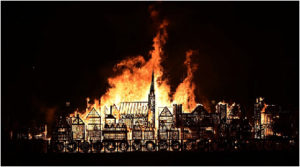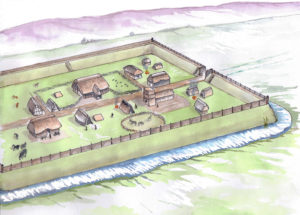After the Romans left Britain, the area we now know as Wales became a group of small independent kingdoms. The area around Longtown was called Ewyas and in the 6th century was ruled by a King Clydawg, who gave his name to Clodock.
By 1055 the Anglo-Saxons had managed to take control of part of Ewyas and a Norman adventurer, Osbern Pentecost, built one of England’s first castles at Ewyas Harold. The remaining part of Ewyas, including Longtown, was ruled by Gwent at the time of the conquest (according to the Book of Llandaff).
 At around this time, King Gruffydd of Powys managed to defeat all the other Welsh princes and, for the first time in its history, Wales had a single ruler. Having gained control of Wales, Gruffydd led an attack into Anglo-Saxon territory. His army entered Hereford, looted the cathedral and burned the city.
At around this time, King Gruffydd of Powys managed to defeat all the other Welsh princes and, for the first time in its history, Wales had a single ruler. Having gained control of Wales, Gruffydd led an attack into Anglo-Saxon territory. His army entered Hereford, looted the cathedral and burned the city.
Earl Harold Godwinson, who later became King Harold, raised an army and chased Gruffydd back into Welsh territory. History records that Harold’s army camped beyond the Dore Valley, which places them at Longtown. Medieval armies used the Roman roads and an old Roman fort would make an ideal place to camp.
 Harold took part of his army back to Hereford where they repaired the city defences with a wide ditch and an earth embankment. The rest of the army were ordered to remain in Wales and prepare for a Welsh attack. It appears that they spent their time deepening the ditch around the Roman fort and raising its ramparts to around 4 metres. This explains why we can see at Longtown a square embankment in the shape of a Roman fort but with the height of the defences typical of a Saxon burh or fortified township.
Harold took part of his army back to Hereford where they repaired the city defences with a wide ditch and an earth embankment. The rest of the army were ordered to remain in Wales and prepare for a Welsh attack. It appears that they spent their time deepening the ditch around the Roman fort and raising its ramparts to around 4 metres. This explains why we can see at Longtown a square embankment in the shape of a Roman fort but with the height of the defences typical of a Saxon burh or fortified township.
The Welsh didn’t attack, but in 1063 Harold and the English army launched an offensive on Gruffydd’s capital at Rhuddlan. The Welsh, realising that defeat was inevitable, murdered their king and sent his head to Harold as a peace offering. With Gruffydd dead, peace was restored and Wales returned to being a number of small kingdoms again.
